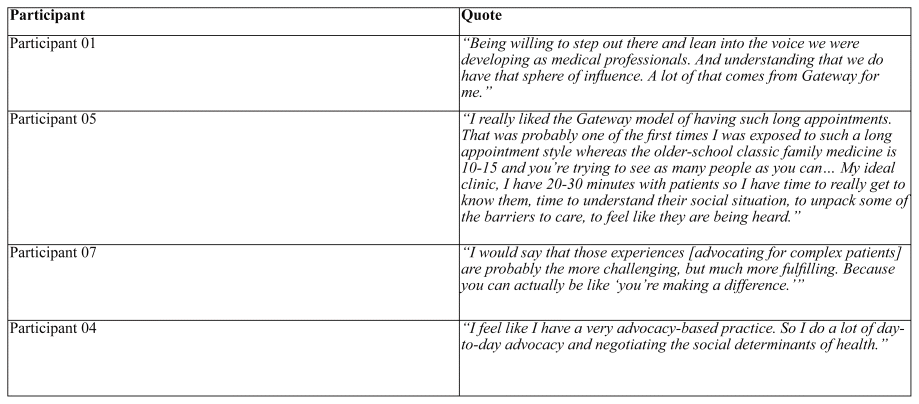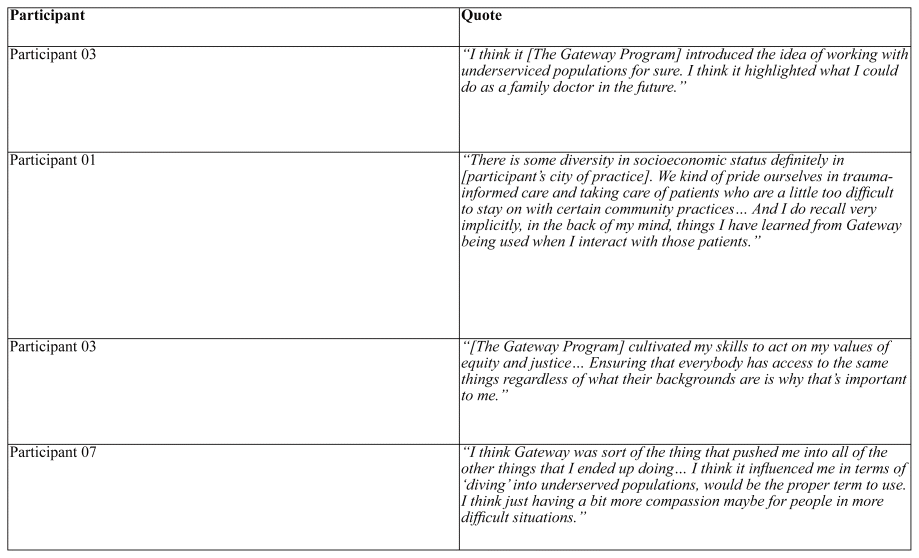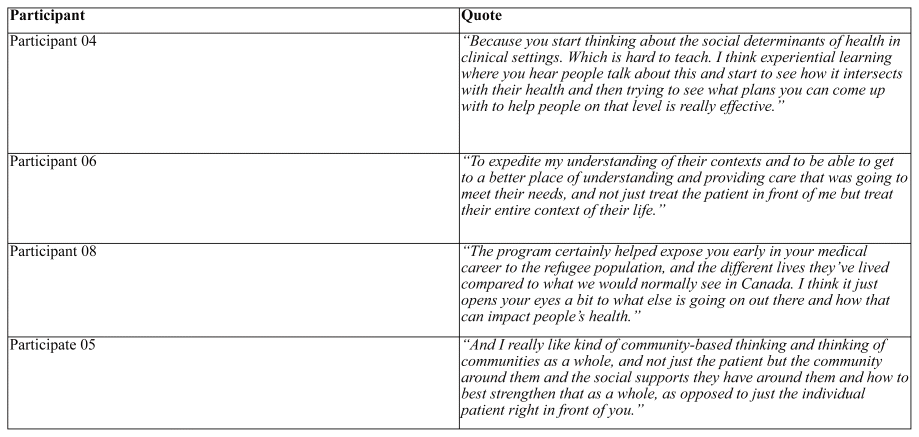
1PhD, Professor of Health Care Ethics, Centre for Bioethics, Memorial University, and Division of Community Health and Humanities, Memorial University, St. John’s, Newfoundland and Labrador, Canada
2BPhil, MD Candidate, Memorial University of Newfoundland and Labrador, St. John’s, Newfoundland and Labrador, Canada
ABSTRACT
Background: Service-learning combines student education with volunteer activities which benefit the community. The authors examined how service-learning through a Canadian medical student-run clinic for refugee newcomers shapes the subsequent practice style of physicians. The clinic (known as “The Gateway Program”) aims to improve access to medical care for refugees in the urban center in which the medical school is located, while teaching students about cross-cultural medicine. The connection between current practice styles and prior service-learning has not been well documented in the literature, despite value existing in examining the impact this educational tool has on physicians. The research question was: How does participation in service-learning shape the manner in which physicians subsequently deliver healthcare? Methods: The study qualitatively examines the experiences of former student coordinators of The Gateway Program who are now practicing Canadian physicians. Eight participants were interviewed. Data was subjected to thematic analysis. Results: Three key themes were identified: Advocacy, Social Determinants of Health, and Transferable Skills for Underserved Populations. Conclusion: Time served in the clinic is reported to have had a profound impact on participants’ current style of practice. The clinic exposed students early in their medical education to a functional model of care for the underserved which valued physician advocacy. As practicing professionals, they were able to draw upon this learning to inform their professional morals and style of practice.
Keywords: Undergraduate medical education, Refugees, Service learning, Professionalism, Advocacy, Practice style
Date submitted: 6-Mar-2024
Email: Fern Brunger (fbrunger@mun.ca)
This is an open access journal, and articles are distributed under the terms of the Creative Commons Attribution-Non Commercial-Share Alike 4.0 License, which allows others to remix, tweak, and build upon the work non-commercially, as long as appropriate credit is given and the new creations are licensed under the identical terms.
Citation: Brunger F, Penney O. A Brief Discussion of the Impact of Service-Learning Experience on Physicians′ Manner of Practice. Educ Health 2024;37:147-151
Online access: www.educationforhealthjournal.org
DOI: 10.62694/efh.2024.42
Published by The Network: Towards Unity for Health
Service-learning allows students to apply course content to activities that serve the community.1 The clinic is a service-learning opportunity available to pre-clerkship medical students. The clinic is managed by the Faculty of Medicine in partnership with the province’s primary resettlement agency and in collaboration with the regional health authority.2 The primary mandate of the clinic is to improve access to medical care for refugees in the urban area in which the medical school is located, while educating pre-clerkship students in cross-cultural medicine. Student participation is voluntary; their role is to conduct interviews and physical screenings with patients (usually working through an interpreter), and then share the health information with supervising family physicians.
Research exists depicting a significant correlation between student-run clinic involvement and physician specialty choice,3–5 while other work denies this correlation.6–8 However, our work delves deeper and explores whether and how previous participation as a student in a student-run clinic has impacted physicians’ current practices. The research question was: How does participation in service-learning shape the manner in which physicians deliver healthcare?
The authors used a qualitative approach to record in-depth accounts from a small purposeful selection of knowledgeable insiders. These insiders are prior clinic coordinators who were highly engaged with the clinic through their leadership role, and who currently practice medicine in Canada. Participants are numbered and are not associated with any specific identifiers beyond these inclusion criteria, due to the small sample size and possibility of readers identifying participants. Conversational interviews were conducted by videoconference using an interview guide. From a recruitment pool of 34 physicians, eight agreed to be interviewed. A consent form was sent to all participants prior to the interview and consent was confirmed at the beginning of each interview. The study has ethics approval from the province’s health research ethics board.
Prior to analysis, all interview data was transcribed and deidentified. The authors conducted a thematic analysis of the interview data to examine the range and types of thoughts and concepts discussed. This is an inductive approach to analysis, which makes an effort to avoid imposing any theoretical expectations on the interview data a priori.9 Unlike hypothesis-driven research, the goal was to describe in detail key themes that emerged from the narratives, to arrive at a meaning-rich account of participant perspectives.
Thematic analysis of the data revealed several themes common to all participants’ interviews including, but not limited to: advocacy work, the social determinants of health, skills which are applicable to working with other underserved populations, relationship-building, interpretation services, learning through discomfort, and challenges faced while providing care. While each of these themes offers meaningful insight, authors chose to interpret data from three themes in this work. These are: Advocacy; Transferable Skills for Working with Underserved Populations; and the Social Determinants of Health. Several direct quotes from participants are included in Tables 1–3 as supporting evidence in the discussion of these interview themes.
Table 1 Participant Quotes Discussing: Advocacy
Table 2 Participant Quotes Discussing: Transferable Skills
Table 3 Participant Quotes Discussing: Social Determinants of Health
Regarding the shared theme of Advocacy, participants spoke about the advocacy work performed at the clinic; the advocacy work they currently do; and any connections existing between these two. The second theme, Transferable Skills for Working with Underserved Populations, refers to participants’ discussion about how skills they learned at the clinic working with newcomers continue to be useful today, with patients who belong to other marginalized or underserved groups in their current practices. Finally, the theme Social Determinants of Health (SDH) was discussed as a useful framework for understanding the barriers to care patients may face due to their socioeconomic status; how the clinic was a successful model for teaching the impacts such factors may have on a person’s health; and how a practitioner can appreciate SDH while providing care.
The structure of the clinic exemplifies how to be an advocate for patients because it unsettles social and professional norms typical of clinic visits in order to better serve the population of refugee newcomers. For example, visits are stretched from the standard 15 minutes to a minimum of an hour to accommodate the time interpretation takes, and to provide time to understand the patient’s context. Exposing learners to this atypical structure prompts them to consider how the “one size fits all” medical system tends to marginalize people whose needs do not fit into that rigid infrastructure. Many participants commented that early exposure to a slower-paced and lengthier clinical visit influenced their current preferred style of practice and their desire to be a physician advocate [Table 1].
A causal link between service-learning at the clinic and physicians incorporating advocacy into their current practices cannot be made from the data. It is of course equally possible that the medical students who entered the program had pre-existing interests in advocacy work. However, what can be highlighted from the data is that the clinic provided medical students with a framework for physician advocacy and a baseline from which to develop their own voices, values, and strategies as advocates. Whether it was an introduction to advocacy, or tailoring existing interests in justice, the clinic was reported to have had a meaningful and lasting impact on participants’ understanding of their own power and influence as physicians.
While not all participants see newcomers in their current practices, all of them presently work with at least one underserved population, including newcomer, Indigenous, rural, unhoused, and geriatric populations. During the interviews, participants commented on how their time working with newcomers at the clinic taught them skills which they employ with other underserved populations, and, for some, directly influenced their choice to pursue this type of practice. [Table 2].
The clinic program seeks to instruct students on how to give culturally safe, trauma-informed, person-centered care to refugee populations. Training sessions, debriefs, feedback from physician advisors, and the clinical encounters themselves teach learners to navigate complex patient interactions with patience, compassion, respect, and with an open mind. Today, these learners still apply the skills they learned from the clinic with newcomer populations and other groups marginalized by the medical system. From the interview data, it appears that exposure to caring for an underserved population through a service-learning experience can contribute to physicians who make an effort to provide socially conscious care—not only to the original population, but to other complex groups as well.
All participants discussed the social determinants of health (SDH) in their interviews. SDH are defined by the World Health Organization as, “non-medical factors that influence health outcomes”.10 They influence health inequities. The clinic provoked and encouraged students to think beyond the patient’s presenting illness and consider their broader life context, and to try to understand how the two are connected. The clinic gave the volunteers the ability to see medicine in a social context through a myriad of explicit guidelines, and implicit guidance. For example, students are encouraged to have two “problem lists”, one for medical issues and another for social issues. [Table 3]
The SDH are a common component of medical education in the theoretical class-based portion. However, the clinic is a powerful educational tool that allows students to expand upon their course knowledge of the SDH and learn to ask about, and appreciate, how they affect real patients’ lives. The clinic also prompts students to think critically about how they can tailor care provision to address social issues and ensure the care is effective and accessible to each individual patient. According to the participant quotes above, this learning at the clinic has had a lasting impact on the physicians’ understanding of the SDH and the manner in which they provide care.
The chief limitation of this study is the small sample size of eight who were non-randomly selected from a likely biased group of 34 due to their high level of engagement with the clinic. Further, participation in the clinic is voluntary, so students may have had a pre-existing interest in service-learning. Nor is this work a comprehensive documentation of the impact the clinic had on involved students, as 26 individuals did not agree to be interviewed. Therefore, this work is limited in scope.
However, this research does contribute to the existing literature by exploring how service-learning can shape future medical practice. It academically documents the formative impact programs (such as The Gateway Program) can have as an educational tool using the participants’ own accounts. The key impacts reported here include: developing an appreciation of the social determinants of health; igniting a passion for advocacy; and a desire to provide care that is accessible to every patient.
Each of the themes discussed here are intertwined. Engaging with the social determinants of health allows physicians to understand how some populations are underserved within the current healthcare infrastructure; they can then use that understanding to improve their own care provision, connect more deeply with patients, and advocate to change the system. The clinic shaped interviewed physicians to practice in this socially conscious way by introducing them early on in training to a functional model of physician advocacy and care for the underserved. Through interacting with the clinic’s systems and values, students were able to further formulate their own morals, and build a vision for the future care they would like to provide as physicians.
1. Wiegand D, Strait M. What is service learning? Journal of Chemical Education. 2000; 77(12), 1538. https://pubs.acs.org/doi/pdf/10.1021/ed081p221?casa_token=2wIQ86Veiv4AAAAA:BLigSFW3JesNvo-7rcdnVIeG-FONBpGJSihIid408nVcyCpUoCnTwBUJ8ADBSRecnu816FOb1Q2UX2lS
Crossref
2. Duke P, Brunger F. The MUN MED Gateway Project: Marrying medical education and social accountability. Canadian Family Physician. 2015; https://www.cfp.ca/content/cfp/61/2/e81.full.pdf
PubMed PMC
3. Campos-Outcalt DE. Specialties chosen by medical students who participated in a student-run, community-based free clinic. American Journal of Preventive Medicine, 1985; 1(4), 50–51. https://doi.org/10.1016/S0749-3797(18)31400-4
Crossref PubMed
4. Smith SD, Yoon R, Johnson M, Natarajan R, Beck E. The effect of involvement in a student-run free clinic project on attitudes toward the underserved and interest in primary care. Journal of Health Care for the Poor and Underserved, 2014; 25(2), 877–889. https://doi.org/10.1353/HPU.2014.0083
Crossref PubMed PMC
5. Wang L, Spinelli MA, Palaniappa NC, Meah YS, Thomas DC. “How does a student-run clinic impact medical student ability to care for patients with chronic illness?” Journal of General Internal Medicine. 2013; 28, S487–S488. https://www.embase.com/search/results?subaction=viewrecordid=L71293770from=export
6. Tong STC, Phillips RL, Berman R. Is exposure to a student-run clinic associated with future primary care practice? Family Medicine. 2012; 44(8), 579–581. https://www.researchgate.net/profile/Sebastian-Tong/publication/230756180_Is_Exposure_to_a_Student-run_Clinic_Associated_With_Future_Primary_Care_Practice/links/55a94b9408ae815a04254597/Is-Exposure-to-a-Student-run-Clinic-Associated-With-Future-Primary-Care-Practice.pdf
PubMed
7. Vaikunth SS, Cesari WA, Norwood K, Satterfield S, Shreve RG, Ryan JP, Lewis JB. Academic achievement and primary care specialty selection of volunteers at a student-run free clinic. Teaching and Learning in Medicine. 2014; 26(2), 129–134. https://doi.org/10.1080/10401334.2014.883980
Crossref PubMed
8. Brown A, Ismail R, Gookin G, Hernandez C, Logan G, Pasarica M. The effect of medical student volunteering in a student-run clinic on specialty choice for residency. Cureus. 2017; 9(1). https://doi.org/10.7759/CUREUS.967
9. Denzin NK, Lincoln YS. (Eds.). The Sage Handbook of Qualitative Research. 5th ed. Thousand Oaks: Sage; 2011
10. World Health Organization. Social Determinants of Health. World Health Organization. Retrieved December 12, 2023 from https://www.who.int/health-topics/social-determinants-of-health#tab=tab_1
© Education for Health.
Education for Health | Volume 37, No. 2, April-June 2024